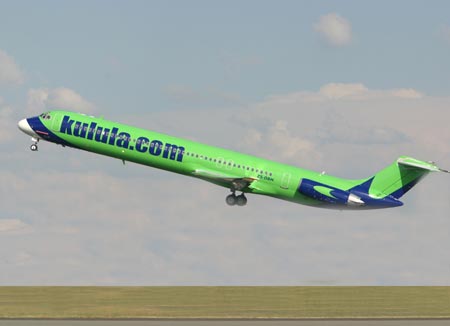Gidon Novick and Erik Venter took over as joint chief executives of Comair in July, replacing Piet van Hoven, who retired after 41 years with the company including 27 as managing director. Novick and Venter are continuing van Hoven’s dual growth strategy of expanding Comair’s British Airways franchise, launched in October 1996, and its Kulula low-cost operation, launched in August 2001.
Since Kulula’s launch the total size of
“There’s been big growth since we introduced low fares five and a half years ago,” says Novick, adding Kulula brought low fares to
Novick has spent his entire career at Comair, initially joining the company eight years ago after earning an MBA in the
 Kulula, Novick says, created a new market by increasing
Kulula, Novick says, created a new market by increasing
Kulula’s almost instantaneous success even prompted a group of former Comair executives, led by former finance director Glenn Orsmond, to leave the company and launch a rival low-cost carrier, 1Time Airline, in early 2004. South African Airways (SAA), battered by a diminishing domestic market share and a sharp drop in domestic yields, finally responded in November by launching its own low-cost subsidiary Mango.
Novick says the addition of a third low-cost carrier will lead to a further reduction in domestic yields but he says Comair is well prepared to weather the “blood bath” because it is strong financially.
“It will be a very big challenge but we’ll manage it,” he says. “They won’t undercut our fares. Our fares will continue to be the lowest.”
Although Comair has a traditional full-service carrier background, Kulula has one of the lowest cost bases in the world, according to Novick. “As a low cost operator we’ve been looking at ways to lower our costs since our launch.”
Comair’s BA business also has continued to expand since Kulula’s launch, driven by growth in
The two brands run side by side on major domestic routes, targeting different sectors of the market. Kulula exclusively operates some domestic leisure routes such as Cape Town-Port Elizabeth and Johannesburg-George. It also operates from a secondary airport in
Kulula currently only serves Lanseria from
In addition to operating major domestic business routes, Comair’s BA franchise competes against South African Airways (SAA) on several short-haul high-yield international routes.
Combined Comair’s two operations generated nearly R2 billion ($287 million) in revenues for the year ending 30 June 2006, an increase of 15% compared with the previous year. The spike was even more impressive for the year ending 30 June 2005, when a 16% increase in revenues was recorded. The company turned a healthy R73 million profit in fiscal 2004-05 followed by a R79 million profit in fiscal 2005-06. Novick expects Comair to continue growing at an 8-10% annual rate for at least the next few years. Even faster growth may be recorded if Comair succeeds in launching a new regional operation.
Comair is now bidding to acquire SA Express, which government holding company Transnet is looking to offload. But government-owned SAA also has expressed interest in acquiring SA Express, which now operates 13 turboprops and regional jets on behalf of SAA.
“We’ve been waiting. The process hasn’t gone fast,” Novick says of the pending sale.

If Comair’s bid for SA Express does not succeed, Novick says Comair may hire another South African regional carrier to operate a fleet of 50 to 70-seat turboprops on behalf of Kulula. The turboprops would be used to bring low fares to smaller South African cities that currently do not have any low-cost operators because their markets are too small to support narrowbody aircraft.
“In terms of route network it’s a challenge. We’re at the tip of
Novick also sees expansion opportunities at the other end of the spectrum. He hopes Comair’s BA franchise will secure the traffic rights needed to launch more short-haul international routes and says long-haul international routes are “a possibility”. But he says for now Comair, which is 15% owned by BA and traded publicly on the
“We still see a lot of opportunity in the local market,” Novick says. “When it slows we’ll look internationally.”
Source: Airline Business



















